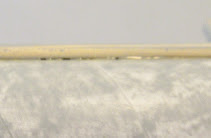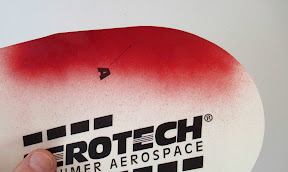I know - I postponed some posts on this build. There are good reasons why.
I'm not very experienced making epoxy fillets. Sure I've done them, but I'm not enough to show you a best method.
Another reason - It's difficult to get an even, gloss paint finish on large rockets using store bought spray cans. If you've ever tried to get a good gloss on a 4" diameter model you know what I mean. You really need a spray gun and maybe an auto body spray booth!
I do have experience with stickers, this kit has peel and stick decor.
But, there are some concerns. Some kit stickers are now printed at Aero tech and require different considerations.
In the past I've wet the surface of the model and dipped the sticker in a dish of water. The water allows repositioning. It's rare when a sticker is perfectly positioned on the first try.
I tried the water dip but it loosened the adhesive on the back of the sticker! Pulling up the sticker to reposition it lifted off the adhesive making the surface lumpy and unacceptable.
Something different about these stickers - Using no water allowed for some lifting and repositioning!
They still grab so be careful when initially setting them on the model surface.
You may have an older Aerotech kit, the stickers might work fine when dipped in water.
TIP: Test using water on some of the blank scrap material between the print images.
It helps to dry position the fin stickers.
Don't peel off the backing yet!
Here is a roll of masking tape on the back of a fin panel.
The decal is dry positioned on the fin and the tape pressed to hold it in place.
With the sticker set on the fin -
Use some small pieces of masking tape to "frame" the sticker centered on the fin.
Lift the sticker panel leaving the tape frame in place.
Peel off the backing and set the sticker on the fin using the masking tape frame to position the sticker.
Smooth out the sticker from the center to the outside edges.
With any luck the other fins should be centered (even white borders) and mirror each other.




















































